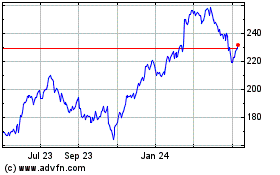Need For Welders Belies Decline in U.S. Manufacturing Jobs
November 23 2009 - 4:38PM
Dow Jones News
The unraveling of U.S. manufacturing employment in the past year
hasn't damped the outlook for welders, whose numbers lag far below
the projected work force needed for increased spending on public
infrastructure and energy projects.
As many as 200,000 additional welders will be needed by 2014, a
40% increase over the current number of welders in the U.S.,
according to industry estimates. Trade schools and training
programs turn out about 25,000 new welders a year, but twice as
many welders leave the trade annually, mostly because of
retirement.
Despite the loss of 1.5 million manufacturing jobs in the past
year, or about a 12% reduction in the total U.S. manufacturing work
force, employers complain that they can't find enough trained
welders. The shortage has prompted some equipment manufacturers to
design welding gear with less-accomplished welders in mind.
"There's truly a talent mismatch," said Jonas Prising, Americas
president for job placement service Manpower Inc. (MAN) "There are
lots of people who are unemployed who'd like to apply for these
welding jobs, but they don't have the skills."
It is a problem that isn't limited to welding. Openings for
machinists and other manual skilled trade workers have been among
the hardest jobs to fill in recent years, according to
Manpower.
As high school shop classes and other vocational career programs
have been pared back in the past 20 years in favor of more college
preparatory curriculums and technology-related courses, teen-agers
have had less exposure to skilled trades.
Parents, many of whom now work in service-sector jobs
themselves, also are reluctant to encourage their children to
pursue skilled trades, fearing that such jobs will disappear like
millions of other manufacturing jobs draining out of the U.S
economy.
Experts say welding, in particular, is often perceived as a
dying occupation being replaced by robot welders in factories or
outsourced to low-wage workers overseas.
"I'll have parents say that robots are taking the jobs away from
welders, but we need welders to run the robots," said David Cotner,
welding department head for the Pennsylvania College of Technology
in Williamsport. "They're the ones who make sure that the robots
are running optimally. It's taken people time to see that welding
isn't just dirty, blacksmith-type work."
Observers say enrollment in training programs is up across the
country as recently displaced workers look for other careers.
Starting pay for newly trained welders is about $36,000 a year and
experienced welders can earn double that amount.
Nevertheless, the flow of new workers into the trade isn't
expected to match the amount of welding work anticipated in the
coming years as bridge structures, transit systems, water plants
and other public infrastructure undergo repairs or replacement.
The American Society of Civil Engineers projected earlier this
year that $2.2 trillion needs to be spent on the aging
infrastructure in the U.S. in the next five years just to keep it
in adequate condition. The U.S. economic stimulus legislation
included about $100 billion for infrastructure improvements.
Meanwhile, the resurgent nuclear-power industry, the
construction of wind-energy turbines and elevated investment in oil
and natural gas pipelines are creating more jobs for welders in the
energy sector.
"We've got to bring more talent into the business. I don't think
there's a single welder coming out of our school who can't get a
job," said Carl Peters, director of training for Cleveland-based
Lincoln Electric Co. (LECO), which has operated its own welding
school since 1917. Lincoln, the world's largest seller of cutting
and welding equipment, this autumn started marketing a
virtual-reality welding simulator to lower schools' costs for
training welders.
The simulator sells for about $46,000, but doesn't consume
fluxes or electrodes and requires less instructor supervision than
an actual electric-welding machine. The simulator provides
computer-generated images to give students experience in applying
molten metal to metal joints.
Other equipment manufactures are adjusting their product lines
to accommodate the shortage of welders. Miller Electric
Manufacturing Co., a unit of industrial conglomerate Illinois Tool
Works Inc. (ITW), has redesigned its welders and simplified the
controls for workers with minimal instruction in welding.
"We understand what the customers' pains are," said Mike Weller,
North American welding president for Wisconsin-based Miller
Electric. "You have a less-trained welder today than ever
before."
-By Bob Tita, Dow Jones Newswires; 312-750-4129;
robert.tita@dowjones.com
Lincoln Electric (NASDAQ:LECO)
Historical Stock Chart
From Mar 2024 to Apr 2024

Lincoln Electric (NASDAQ:LECO)
Historical Stock Chart
From Apr 2023 to Apr 2024
